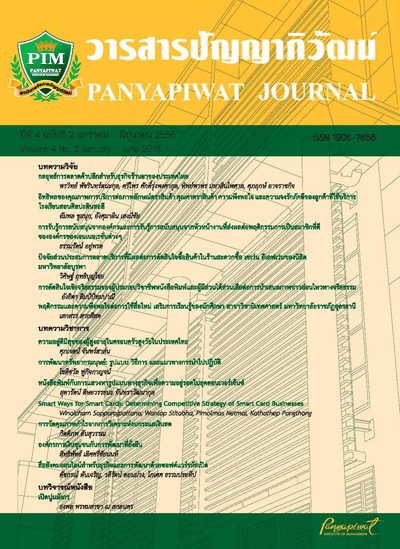การพัฒนาทรัพยากรมนุษย์: รูปแบบ วิธีการ และแนวทางการนำไปปฏิบัติ
Main Article Content
Abstract
การพัฒนาทรัพยากรมนุษย์สามารถแบ่งได้เป็นสามรูปแบบ ได้แก่ การศึกษา การฝึกอบรม และการสนับสนุน การศึกษา คือ การมุ่งพัฒนาทรัพยากรมนุษย์เพื่อการดำเนินชีวิต และเตรียมพร้อมสำหรับการปฏิบัติงาน เช่น การศึกษาในระบบ การศึกษานอกระบบ การศึกษาตามอัธยาศัย เป็นต้น ส่วนการฝึกอบรม คือ การพัฒนาทรัพยากรมนุษย์เพื่อเพิ่มศักยภาพในการปฏิบัติงาน เช่น การบรรยาย การระดมสมอง การสาธิต ฯลฯ และการสนับสนุน คือ การพัฒนาทรัพยากรมนุษย์เพื่อเพิ่มศักยภาพเฉพาะบุคคลในการปฏิบัติงาน เช่น การสอนงาน การหมุนเวียนงาน การใช้แนวทางชุมชนนักปฏิบัติ เป็นต้น การศึกษาจึงมีขอบข่ายที่กว้างกว่าการฝึกอบรม และการฝึกอบรมจะมีขอบข่ายที่กว้างกว่าการสนับสนุน อย่างไรก็ตามทั้งสามรูปแบบสามารถนำมาพัฒนาศักยภาพของมนุษย์ได้ทั้งแปดด้าน ได้แก่ ด้านศาสนา ด้านสุขภาพ ด้านสติปัญญา ด้านความรู้ ด้านทักษะ ด้านเจตคติ ด้านประสบการณ์ และด้านบุคลิกภาพ ส่วนขั้นตอนในการพัฒนานั้นควรเริ่มจากการประเมินความจำเป็น การวางแผน การเตรียมการ การดำเนินการพัฒนา และการประเมินผลการดำเนินการพัฒนา และการประเมินผลการปฏิบัติงานหลังจากการพัฒนาทั้งในเชิงประสิทธิภาพ และประสิทธิผล
There are three kinds of human resource development covering education, training, and supporting. The purpose of education is to develop human resources to be ready for their living and working such as formal education, non-formal education, informal education, etc. Training is designed to develop the capacity of human resources in their work, for example lecture, brainstorming, demonstration, etc., whereas supporting is intended to increase personal capacity such as coaching, job rotation, community of practice, etc. Therefore, education has wider ranges than training. At the same time, training has wider scopes than supporting. However, all three types are designed to develop human potentials in eight aspects: religion, health, intelligence, knowledge, skills, attitude, experience, and personality. The process of development should start from need assessment. Later, planning, preparation, and implementation will be done. Lastly, evaluating the results of development and implementation will be conducted both in terms of efficiency and effectiveness to provide further improvement
Article Details
I and co-author(s) certify that articles of this proposal had not yet been published and is not in the process of publication in journals or other published sources. I and co-author accept the rules of the manuscript consideration. Both agree that the editors have the right to consider and make recommendations to the appropriate source. With this rights offering articles that have been published to Panyapiwat Institute of Management. If there is a claim of copyright infringement on the part of the text or graphics that appear in the article. I and co-author(s) agree on sole responsibility.
References
Gilley, J. W., Eggland, S. A., & Gilley, A. M. (2002). Principles of human resource development.2nd ed. Cambridge: Perseus.
Nadler, L. (1990). Human resource development. pp. 1.1-1.47. In L. Nadler & Z. Nadler, eds.The handbook of human resource development. 2nd ed. New York: John Wiley & Sons.
Swanson, R. A., & Holton, E. F. (2001). Foundations of human resource development. San Francisco: Berrett-Koehler.
Swart, J., Mann, C., Brown, S., & Price, A. (2005). Human resource development: Strategy and tactics. Chennai: Charon Tec Pvt.
Walton, J. (1999). Strategic human resource development. London: Financial Times Management.
Yorks, L. (2005). Strategic human resource development. Mason, OH: South Western Thomson.


